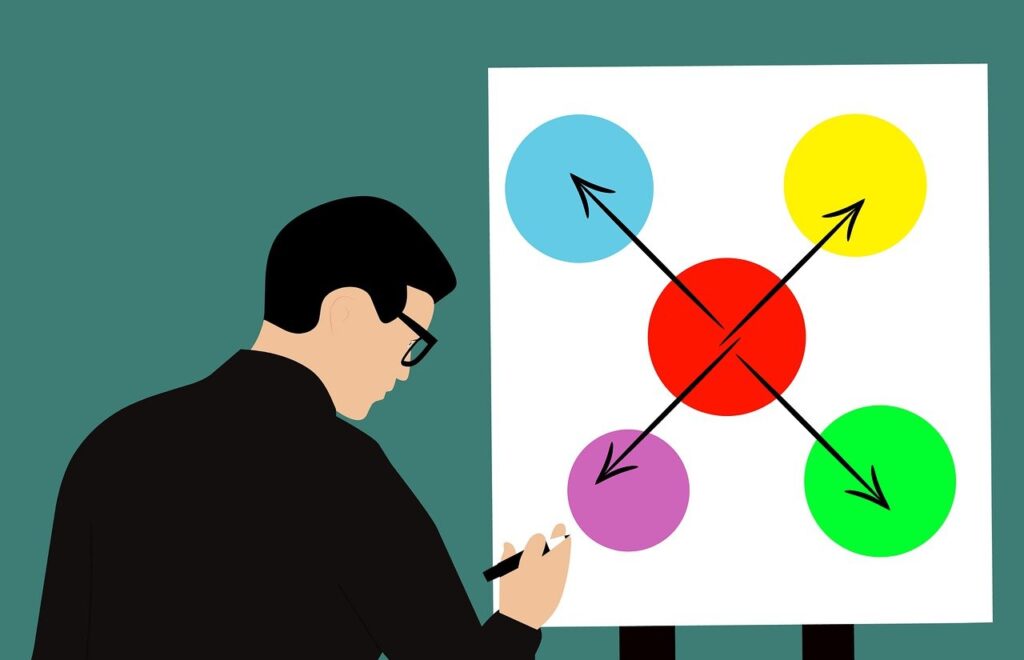Mind maps are versatile tools that can greatly enhance problem-solving and decision-making processes. By visually organizing information and exploring connections, mind maps help to clarify complex problems, generate innovative solutions, and facilitate effective decision-making. In this article, we will dive deep into the practical techniques and strategies for using mind maps to solve problems and make informed decisions.
1. Define the Problem or Decision
Embark on your problem-solving and decision-making journey with mind maps by taking the crucial initial step of clearly defining the specific challenge or decision you’re facing. Articulate the issue at hand with precision and clarity, setting the stage for effective problem-solving and informed decision-making. Write down the central topic in the center of your mind map.
2. Generate Ideas and Solutions
Once the problem or decision is defined, use the branches of the mind map to generate ideas and potential solutions. Start with the main branches representing different categories or aspects related to the problem or decision. Then, branch out further to explore sub-ideas or possible solutions. Allow yourself to brainstorm freely, capturing every idea that comes to mind.
3. Organize and Prioritize
After generating a range of ideas and solutions, it’s important to organize and prioritize them. Use the branches and sub-branches of the mind map to categorize and group similar ideas or solutions together. This will help you identify patterns, relationships, and potential dependencies. Additionally, prioritize the ideas or solutions based on their feasibility, impact, or other relevant criteria.
4. Evaluate and Analyze
With the ideas and solutions organized, it’s time to evaluate and analyze them in more detail. Consider the positives and negatives of each option, their potential risks and benefits, and their alignment with the problem or decision at hand. Use the branches and sub-branches of the mind map to jot down relevant information, arguments, and supporting evidence.
5. Make an Informed Decision
Based on the evaluation and analysis, you can now make an informed decision. Take into account the insights and information gathered from the mind map. Consider the implications, consequences, and potential outcomes of each option. Select the option that best aligns with your goals, values, and the desired outcome.
6. Take Action and Implement
After making the decision, it’s time to take action and implement the chosen solution. Use the mind map as a reference and guide throughout the implementation process. Assign tasks, set deadlines, and track progress using the branches and sub-branches of the mind map. This will help you stay organized and ensure that the implementation proceeds smoothly.
7. Review and Reflect
Once the solution has been implemented, take the time to review and reflect on the outcomes. Evaluate the effectiveness of the decision and identify any areas for improvement. Use the mind map to capture lessons learned, insights gained, and potential adjustments for future problem-solving or decision-making processes.
Read more on Mind Mapping
THE BENEFITS OF DIGITAL MIND MAPPING TOOLS VS. HAND-DRAWN MIND MAPS
HOW TO USE MIND MAPS FOR STUDYING AND LEARNING
THE SCIENCE OF MIND MAPPING: HOW IT WORKS AND WHY IT’S EFFECTIVE
FAQs
- Can mind maps be used for both personal and professional problem-solving? Yes, mind maps are highly versatile and can be used for both personal and professional problem-solving. Whether you’re tackling a work-related challenge or making decisions in your personal life, mind maps can help you organize your thoughts and generate innovative solutions.
- Are there any specific techniques or guidelines for using mind maps in problem-solving? While there are no strict rules, it’s helpful to follow some guidelines when using mind maps for problem-solving. These include clearly defining the problem, brainstorming freely, organizing and prioritizing ideas, evaluating options, making informed decisions, and reflecting on outcomes.
- Can mind maps be used collaboratively for group problem-solving? Absolutely! Mind maps can be a powerful tool for collaborative problem-solving. By involving multiple perspectives and ideas, mind maps can facilitate team discussions, encourage participation, and enhance collective decision-making processes.
- Are there any research studies on the effectiveness of mind maps in problem-solving? Yes, several research studies have explored the effectiveness of mind maps in problem-solving. For example, a study by Popova and Litvina (2018) found that mind maps can aid in creative cognitive mapping for decision-making processes. Additionally, studies by Farrand, Hussain, and Hennessy (2002), Jusoff and AL‐Abdullah (2010), and Singh and Arora (2019) have examined the efficacy of mind maps in enhancing learning experiences and problem-solving skills







